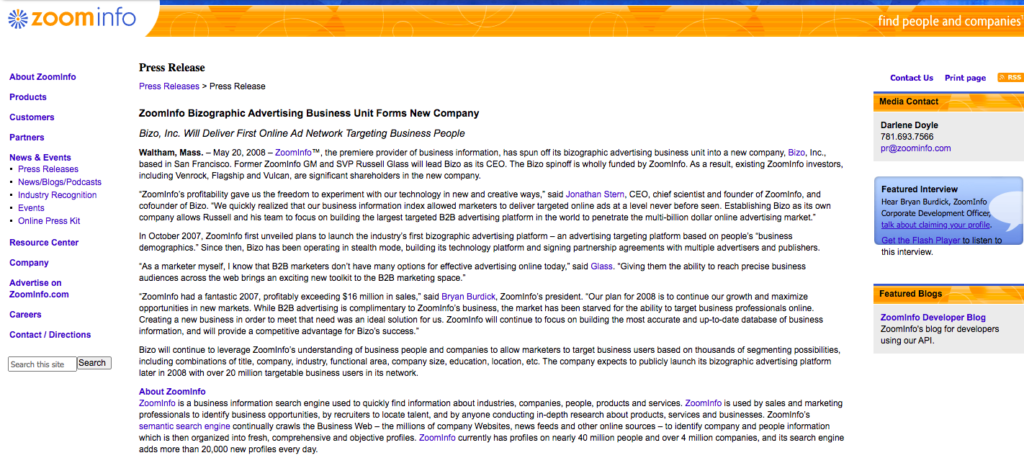Innovation can be tricky. More often than not, it leads you to new frontiers. But other times, you can carve a new path forward by returning to old ideas and finding a new way to use them.
As the person responsible for Innovation at ZoomInfo, a core part of my job is understanding markets where we do not currently offer a solution — but might want to in the future.
Recently, I was trying to understand how we could venture into the advertising space. I thought: “We have all of this data. There must be a way that we can activate it in the advertising space to drive value for our customers.”
My research landed me squarely on Bizo, a company that once aspired marketers to “precisely target business people by specific business demographic criteria.” That description sounds quite a bit like ZoomInfo’s core offering today.
Bizo was founded in 2008 when it was spun out of its parent company. A sobering detail in the press release from the spin-out is how much the quotes read like they were given by marketing experts today.
Seriously, raise your hand if you’ve heard these pain points recently: “The market has been starved for the ability to target business professionals online” … “B2B marketers don’t have many options for effective advertising online today.”
Digging Deeper: What Happened to Bizo?
By 2013, Bizo was the leading business audience marketing company in the world, with data that reached more than 120 million business professionals. This all begs the question: What happened? Why don’t I hear about Bizo?
The answer is a tale as old as time: In 2014, LinkedIn acquired Bizo for $175 million, just six years after Bizo was spun out of its parent company. And just 18 months after the acquisition, LinkedIn said they had misjudged the amount of work it would take to integrate Bizo into their services. The decision to fold Bizo was made in early 2016.
Since then, no solutions have been able to offer business audiences like Bizo did.
There’s a reason I’m talking about Bizo so much. It’s because that parent company that started Bizo? It was ZoomInfo.
At the time, then ZoomInfo Co-Founder and CEO Yonathan Stern provided the rationale for spinning off Bizo. “We realized our business information index allowed marketers to deliver targeted online ads at a level never before seen.”
Twelve years later, I came to the exact same conclusion myself.

ZoomInfo’s press release announcing the Bizo spin-off.
If ZoomInfo’s business data “belonged” in the advertising audience world back in 2008, why wouldn’t it belong there now? I decided to dig deeper to learn about the limitations in digital advertising — and specifically, audience solutions.
What’s common knowledge to those in the industry — but not to a bright-eyed data guy like me — is that advertising audiences aren’t engineered to be precise. Quite the opposite, actually: This space is all about volume, and audience expansion through inferences has taken over.
One expert invited me to examine my own ‘profile’ on the websites of the largest companies that broker advertising data to see for myself. The results? Well, they weren’t exactly accurate. For instance, according to Google, I fall into the following inaccurate audiences:
Employer Size: 1-249 people (ZoomInfo has more than 2,500 employees.)
Education Status: Bachelor’s degree (I have a Master’s degree and a Professional degree.)
Company Industry: Financial Services (Wrong industry.)
Marital Status: Married with children (I’m single and have no kids.)
Pet Owner: Yes (I do not own any pets.)
While I now understand why I keep getting pet food commercials when watching Youtube, this practice of gratuitous over-inclusion in advertising audiences is a perfect example of why we’re so excited about what can be done with ZoomInfo Marketing.
Introducing B2B Advertising with ZoomInfo Marketing
No guessing. What you see is what you get. And what you get is the ability to target any type of professional and any type of company.
Our product is unlike any other for two reasons. First, we’ve amassed a treasure trove of emails, phone numbers, and titles. Second, we’ve architected our company data to let you identify companies with a level of granularity that significantly eclipses the competition.
Was this always intentional? Of course not. But unbeknownst to me, our data became tailor-made for advertising activation as a result of other projects at ZoomInfo.
For instance, when the pandemic hit, our data team went into overdrive on collecting mobile numbers. Office lines no longer did the trick, but mobiles certainly did. And we added 18M of our now 33M mobile numbers in a span of five months.
Additionally, a core focus for ZoomInfo in 2020 was to better enable recruiters to find new candidates using our platform. We heavily invested in collecting millions upon millions of consumer email addresses for the professionals in our platform.
Finally, in October of 2020, ZoomInfo acquired Clickagy, a leading provider of artificial intelligence-powered behavioral B2B intent data. Clickagy’s data not only fuels ZoomInfo’s intent product, but it also fuels the advertising campaigns in ZoomInfo Marketing with intent-driven audience data itself.
With the team at Clickagy now on the ZoomInfo team, our familiarity with the advertising space accelerated from 0 to 60 mph almost overnight. The combination of our massive Data Cloud with a select few experts in advertising data allowed us to quickly discover the path to making our data actionable.
The Road to Customer Success
The digital ecosystem is noisy — and the modern buyer is busy. Advertising campaigns in ZoomInfo Marketing cut out the noise and create a clear path for companies to find the right customers.
A sales enablement software company can now create an audience consisting solely of sales employees at companies with 20+ people in sales and target ads to them.
For the first time ever, optometrists can actually place targeted ads to audiences consisting of employees at companies with vision insurance. Business data can be useful to consumer brands as well. Don’t you think Rolex or Maserati would see success targeting executives at all companies with 500+ employees?
Tailor-made company attributes that allow businesses to reach the right people, at the right time, with the right message. Sound expansive? Maybe. But starting what Bizo finished is a hero’s journey in innovation.
It was more than 14 years in the making, but we finally found our breakthrough.


